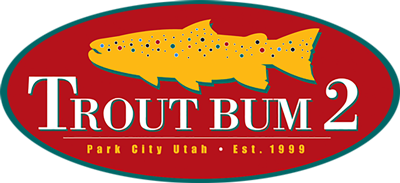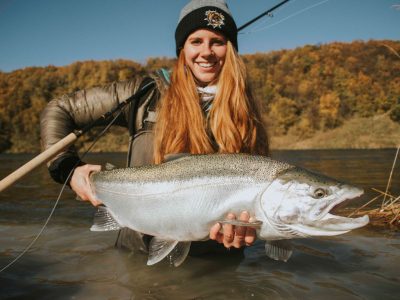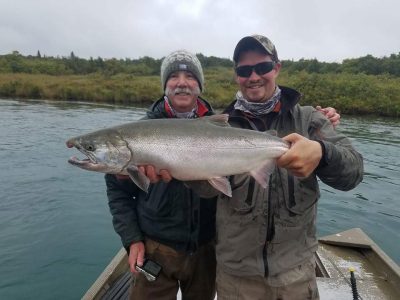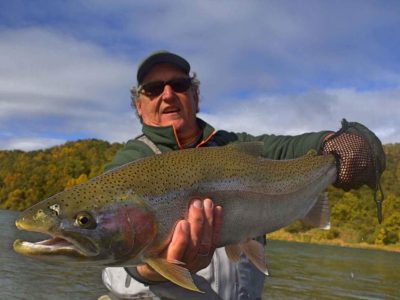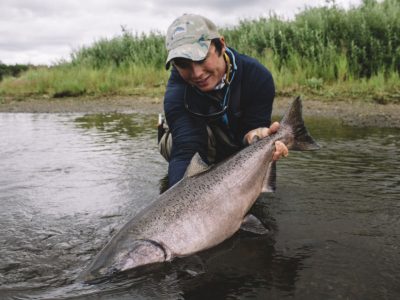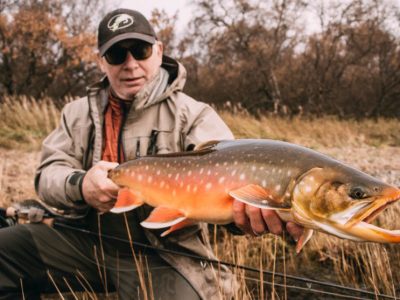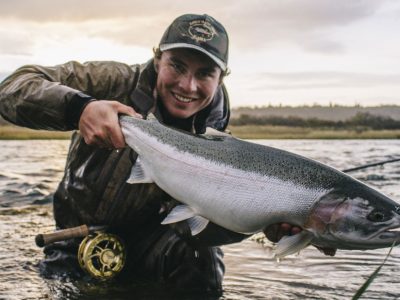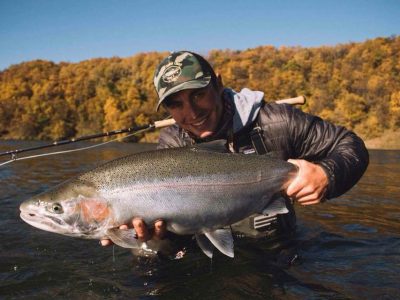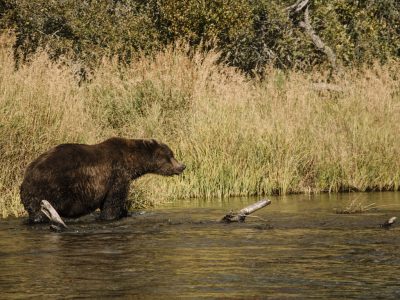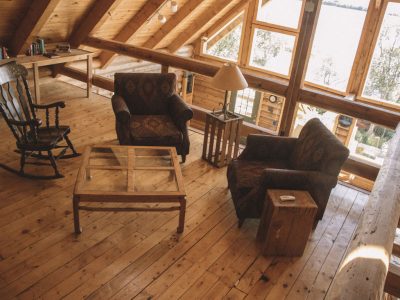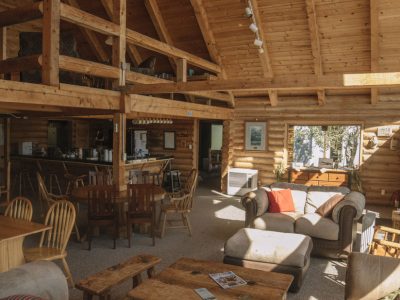Contact Us or host Aaron Adams for more information on any openings at the Blue Bonefish Lodge and/or upcoming availability.
Location & Destination Overview
Our past trips have focused on trophy rainbow fishing and have been extremely productive. Swinging flies and streamer fishing are the most popular methods on the Naknek for trophy rainbows at these times in late fall. We here at TB2 will focus on two handed setups when fishing at KTL in the fall months. As an important note, single hand streamer fishing should be highlighted as an option. Fly out trips are usually limited late in the season, but when available offer great nymph fishing as a secondary option if again swinging flies isn’t your go to method. But, If you are interested in learning more or perfecting your techniques and skills for West coast style steelhead fishing, then this trip is definitely for the novice or experienced angler alike come September and October. The Naknek river is very particular in its nature of fish, and there are very few places like it in the world. Katmai Trophy Lodge has the best beats outside their front door, and boasts some of the best guides in Alaska that have years of experience and a passion for your success. Its a must see.
Open dates at http://www.katmaitrophylodge.com and their sister operation http://www.naknekrivercamp.com are available. Read on to learn about this trip or Contact us below for more information.
The Lodge
The Katmai Trophy lodge is located on the Naknek river just below a section of water known as “The Rapids”. Its location between Naknek lane and the lower stretches of the river allow for easy access to the famous Naknek itself and many of its productive smaller tributaries. This perfect location allows for a short boat ride leading to a diversity of fishing opportunities in the area. Its access also allows for easy fly out trips into more remote areas of the Bristol Bay region for a more solitary and expansive experience. The lodge has been featured on the current programming of long running publication “Fly Rod Chronicles with Curtis Fleming.” Check out their current 2018 episodes fishing KTL on the Pursuit channel.
The Fishing
The fishing near and around the Katmai Trophy lodge is simply world class. Whether it be large Alaskan rainbow trout or even one of the five species of Salmon you are searching for, the Naknek river system and surrounding areas of Bristol Bay offer it all. Bucket list rivers in the likes of the Moraine, Brooks and Alagnak are within easy reach and fishing distance for the angler. There is also good fishing for dolly varden, arctic char and grayling. The beauty of these fish can make for a wonderful day on the water for anyone. Depending on the season and species you are looking to chase, the summer and fall months at Katmai Trophy offer plentiful options and opportunities for the fish of a lifetime.
Rainbow Trout fishing– The bucket list for many on the fly is trophy rainbow trout fishing in Alaska. The Katmai Trophy is in and around some of the best trout fishing in the world. The Naknek itself is considered by many as one of the finest year round resident rainbow fisheries available. It is here that the magical 30 inch trout can be caught on a realistic basis. Charter fly-out out trips into smaller and more remote areas of Bristol Bay can offer the angler an experience of solitude searching for leopard spotted rainbows that may never have seen a fly. Depending on the season, the tactics will change for these native fish and the manner in which the angler will pursue them.
- June-July--This is the season of the streamer. They say the “tug is the drug”, and streamer guys know why! These hard fighting trout in the early season can be eager to chase down and hammer your fly, literally pulling the rod out of your hand. This is a good time to come before the major crowds arrive for salmon season, and can be great fishing for these large predators.
- August-Mid September—The arrival of the Salmon into the system turn these large residents into flesh and bead eating machines. This is the time when the trout just take it easy and engulf the massive drop by spawners that is so easily and readily available for their source of survival. These eggs and dying resource of Salmon will help fatten these fish up and get them through the winter season as their proteins become harder and harder to come by.
- Mid September-October–As the season winds down and the weather becomes less predictable, the Salmon populations have dwindled and carried on the cycle of life. It is now time for the trout to turn back into early season form and hunt down large streamer style flies. This is a great time to bring out the two-handed rod and swing for some of the fattest and hardest fighting fish of the season. For many, this is the time when the trophy of Alaska allows an angler to see her grace. Beautiful colors, changing weather patterns, and large rainbow trout encompass the late season at Katmai Trophy.
Salmon fishing– The Salmon fishing in the Bristol Bay area is about as good as it gets. Located in the heart of Bristol Bay, the Naknek region is a unique area that has returns of all 5 species within distance of the lodge.
- Chinook(King) Salmon—June 20-July 31–These beast of a fish are a favorite to target on the fly for many. Extremely hard fighting fish, they will test your gear and strength. Depending on your method of fly deliverance, single hand rods or even double hand rods are used to handle these bruisers.
- Sockeye(Red)Salmon—Late June thru mid July–Pound for pound, Sockeye Salmon are known to be great fighters on the fly rod. Averaging 5-7 pounds, they are excellent table fare if you are looking to keep some of your targeted species. Your guide will clean, fillet, vaccum seal, and freeze your catch. They will be ready to take in an insulated box for travel on your flight home.
- Coho(Silver)Salmon—Early August thru mid September–Silver Salmon enter the system in early August and inhabit the main river and many tributary creeks that enter the Naknek. Silver Salmon are aggressive fish and are very receptive to the fly. Hard fighters that like to jump and put on a show, these fish are fun to catch. Also great table fare, these fish can be harvested and taken on your flight home.
- Chum(Dog) and Pink(Humpy)—July thru mid September–Because these fish are not the best to eat, they seem not to be targeted at the same rate as the other Salmon species. But, these fish can hammer a fly and put a good bend in the rod no doubt. With the average Chum around 10 pounds, and the Pinks averaging in the neighborhood of 6 pounds, these are still fun quarry on the fly.
Dolly Varden– These sea run char make their migration from winter in the ocean to the rivers of Alaska in order to continue their cycle of life in the summer and fall. Dollies take this time in the river system to gain weight and get ready for the spawn. They can be aggressive eaters of the artificial, while enjoying even eating a dry fly or two that are cast in good fashion.
Arctic Char–These char differ from their cousins the dolly varden in that their migration does not take them to the ocean. These fish will instead spend much of their winter in the lakes before finding their river of choice and spending time to spawn. This process is repeated by the arctic char year after year. The potential of fishing for 30 inch plus char in the Bristol Bay region is certainly possible, and it is attained season after season by a few lucky anglers. A simple photo of these fish are worth casting to them no doubt.
Arctic Grayling–Certainly not one of the largest fish you will encounter in the Bristol Bay region, but maybe one of the prettiest. The colorful dorsal fin of the grayling is known to take anglers to far destinations in search of their beauty. Because of their limited numbers in the lower 48, they are usually very few and far between. In Alaska they are abundant, and their average size is in the mid teens. Crossing this fish off the list on the fly should be accomplished, and it is extremely possible here at Katmai Trophy lodge.
Accomodations and Meals
The accommodations at Katmai Trophy feel like home. With decades of experience in the fly fishing industry, Jim and Phyllis Johnson understand what it takes to run a fishing operation. They realize that great fishing needs to be accompanied by warm hospitality, good meals, and comfortable lodging. They have accomplished this at Katmai Trophy lodge without breaking the bank and making you feel guilty in order to chase experiences of a lifetime. Their mission is to provide world class fishing to people who otherwise wouldn’t be able to see Alaska, without taking out a second mortgage on their home. The Johnsons have done this here. They start with offering 5 rooms in the main lodging area, and 2 private guest cabins outside. Rooms have queen beds with either a bunk combo or twin bed combination. All rooms will have their own bathroom w/ shower, mini-fridge, and heater. The lobby of the lodge includes a large dining area and a social space that creates great conversation before or after a day on the water. It can also just be a comfortable place to hang up the feet and relax. All Meals are included in the package at Katmai Trophy.
Travel
Getting to the Katmai Trophy lodge will first begin with your arrival into Anchorage Alaska (ANC). Alaska, United, Delta, and American Airlines will travel into Anchorage. You will then fly Alaska Airlines into King Salmon Alaska(AKN). Pennair also can accommodate travel into King Salmon(AKN). Mention that you are a client of Katmai Trophy lodge, and a small discount will be given with Pennair. You will be met at the airport and brought to Katmai Trophy lodge via one of the lodge employees. It is recommended leaving at least a one hour connection time in Anchorage.
Equipment Needed
The Equipment necessary for the Bristol Bay region will depend on the species you are targeting and the time of season you will be fishing. Whether it is single hand rods or two handed switch and spey set ups, Troutbum2 or your host will be very versed and knowledgeable in getting you prepared for your travel needs. Refer to your pre-trip planner for more detailed information after booking.
- Rainbow Trout Equipment–Depending on the season and method of fishing you are pursuing rainbow trout in Alaska, will determine your arsenal of equipment.
- Single hand rods–If nymphing for rainbow trout during times like the bead hatch on larger rivers, then a 7 or 8 weight rod is preferable with a W/F floating line. Smaller water in the bush are suited better with a 6 weight, so be prepared. Longer length rods have become popular in the 10′ range, which allow for extended reach while casting and easier mending capabilities especially on big water. A more common 9′ rod will do just fine though, especially when traveling and fishing in the back-country.
- Switch/Spey rods— A 7 weight switch rod can also be used for indicator nymphing if that is what you prefer when wanting to cover a little more water and enjoy the extended help for mending the line on larger rivers. A floating switch line and a standard leader setup are best for indicator nymphing. When fishing switch/spey rods and swinging the fly, then an 8 weight switch and or a 7 weight spey rod are recommended. Line types and sink rates will be determined by the water you will be fishing. It is recommended to have a selection of Airflo Skagit style heads for throwing heavier tips and flies. It is also nice to have a system of Airflo Rage style heads that can turn over poly-leaders easily and are more effective to fish in smaller, slower, and shallower sections of the runs or river where Skagit heads and tips may struggle.
- Salmon Equipment–Again, the equipment necessary for fishing Salmon on the fly will be determined by the season and also species you will be fishing. If you have only one rod for Salmon, make sure it’s at least a 9′ 8 weight with a W/F floating line and a Versatip selection. A little longer rod in the neighborhood of 10′ is ideal if purchasing a new setup. Switch and spey rods have also become very popular for indicator nymphing and swinging flies for Salmon. Large arbor reels with a solid drag are recommended. Below are more specific and detailed setups for each species.
- King–Single hand rods or two handed versions, the King will test your gear. A minimum 8 or 9 weight single hand rod is required for kings when nymph fishing, and longer 10′ rods would be recommended. When fishing two handed rods and swinging streamers then it is nice to fish a 9 weight rod such as the ECHO King. Either setup should have a stiff butt section with enough power to lift heavy tips and flies, but to also handle the brut strength these fish will provide. If fishing a single hand rod, then a versatip style line is a great choice to begin with in varying grain weights to get the fly down. When fishing spey rods, then having a Skagit head is a great start which will turn over large flies and heavier tips easier than Scandi or longer belly lines.
- Sockeye–For sockeye Salmon, you will want an 8 weight rod in lengths of 9’6”- 10′. 9 foot rods are fine, it’s just a little easier to reach the seams and mend the line with a little longer rod. Floating line w/ versatips is recommended for single hand rod selections. Fishing an 8 weight 10’6” or 11′ switch rod is also fun and gaining much popularity for sockeye. For line selection on switch rods, a Skagit compact line and tips for swinging flies is appropriate.
- Coho–Also known as silvers, these dime bright fish are great fun on a fly. An 8 weight 9 foot single hand rod w/ a versatip selection work great for coho. Again, longer single hand rods dont hurt here. If you are fishing a switch rod, then a 7-8 weight with a Skagit compact head and tips to suit will get you where you need to be.
- Chum(Dog)–Chum Salmon may be responsible for breaking more rods than any other salmon, not because of their size, but because of their bulldog mentality. Using an 8-9 weight single hand for chum will do the trick. Lines for single hand rods should be floating with a selection of versatips. 8 or 9 weight switch rods matching grain weight lines in the range of 450-570 work great. Spey rods in 8 or 9 weight category matching grain weights up to 600 are suitable as well. Heads for two-handed rods should be similar to the Rage or Scandi style which will fish polyleaders and smaller flies off of shallow gravel bars the best. Also have a Skagit head w/ tips for deeper faster water when the fish have been pushed out of the softer flows.
- Pink(Humpy)–Pinks can be found in great numbers and are fun for the novice and experienced angler alike. A 7 or 8 weight single hand rod with floating W/F line and a standard salmon/steelhead leader is a great option. Rod lengths of 9-10 feet are the most useful. 6 or 7 weight switch rods 10’6”-11’6” in length are also fun and popular. With the two handed rods a Switch, Scandi, or Rage head style that can handle floating and sinking polyleaders are your go to setup. Pinks tend to run along shallow gravel bars or sit high in the water column and are many times eager to chase and grab flies.
- Char Equipment–During spawning times, these fish display an array of bright colors and beautiful spotting characteristics. They can make great photos for the angler, and grow to extended lengths when mother nature charms their soul. Fast action saltwater 9′ 6 weight single hand rods with a fighting butt is perfect if you only have one char rod. If fishing a switch rod then a 5 or 6 weight switch in shorter sizes is a good go to. Floating W/F fly lines are most useful for single handers. Switch or Skagit compact lines are great for two handers here depending on fishing method. Having a set of tips or polyleaders is not a bad idea to get the fly down if necessary.
- Grayling Equipment–The beauty and grace of a grayling is something many anglers strive for when fishing light line and dry fly methods in Alaska. A simple 5 weight single hand rod is nice to have in the quiver. W/F floating lines are most useful that will be tapered to 4x or 5x tippet. Grayling can take a number of different flies, and can be finicky eaters when they are focused on a particular stage of insect similar to rising trout.
Rates
Includes 7 nights lodging and meals and 6 days of guided fishing including 1 day of guided fishing/bear viewing on the famous Brooks River.
This package adds 3 guided float plane fly-outs (weather dependent) to the standard package.
**50% deposit required to secure spaces**
**Not Included: Flights to and from King Salmon, Alcohol, Taxes, Fishing Licenses, Gratuities, Fish Box or Cooler**
Booking INfo
Please fill out this form, call trip host Aaron Adams at 801-230-3194 or call the shop at 435-658-1166 to learn more or inquire about booking.
